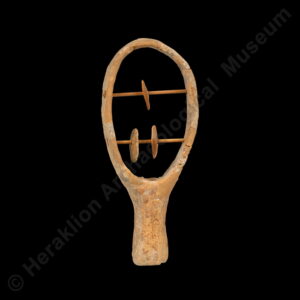
An Egyptian-inspired musical instrument adopted by the Minoans as a ritual instrument, as we see from the iconography. The shape is known to us from clay models and metal examples found in tombs and houses, and also from depictions, the most famous being that on the stone Harvester Vase from Agia Triada. The instrument consists of a flat oval frame and a cylindrical handle. Horizontal rods with discs were affixed to the band. The discs rattled when the sistrum was shaken. In historical times, particularly the Hellenistic period, the sistrum was associated with Egyptian influences. This is evident from images of Isis-Persephone, who is depicted holding a sistrum with which she regulated the rise and fall of the Nile.